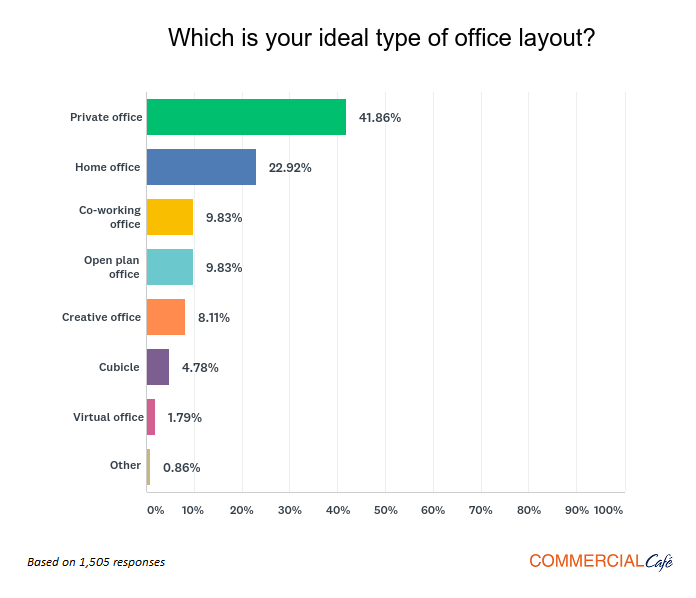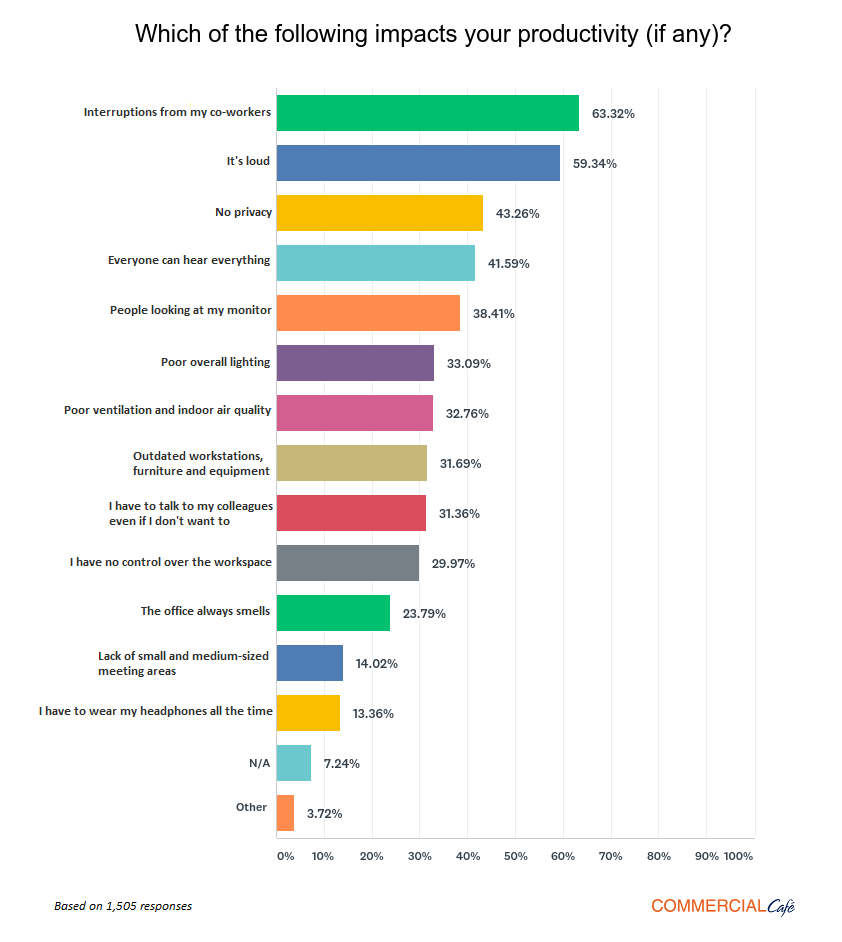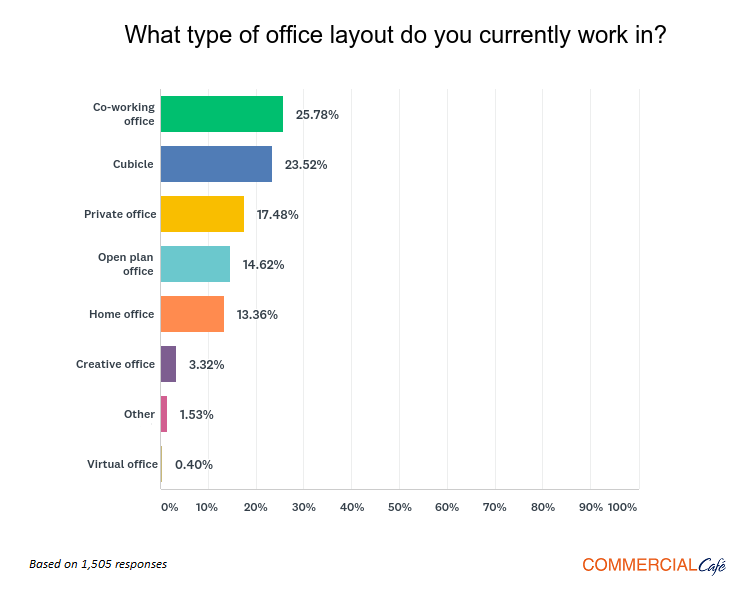Workspace Layout Survey: Privacy Still Most Elusive Office Perk
There’s no doubt that the physical work environment has a big impact on productivity and employee satisfaction, and research abounds on this matter. The typical office design has undergone several transformations over the years, going from private offices to Herman Miller’s cubicles, then onto open-plan layouts, creative offices and the now-trendy co-working spaces. Such transformations are usually driven by different factors: cost-effectiveness, growing/changing number of employees, flexibility, company culture, and so on. But what do the people who work in these offices really want?
As the debate surrounding the effectiveness of the open-office design continues to heat up, we thought we’d check in with office users to see how they feel about their workspaces. We conducted a survey on 1,505 respondents from all around the U.S., asking them about their current office layout, if and how it affects their work, and what type of layout they consider ideal. Keep reading to see what they said.
In the Age of Openness, People Still Crave That Corner Office
Looking back at how the look and feel of workspaces evolved through the years, the evolution seems cyclical, as Miller’s semi-enclosed cubicle originated in the need for privacy, which back in the early 1960s was just as sought-after an office perk as it is today. Then, as the number of white collar jobs expanded significantly and at a rapid pace, cubicles were no longer the best choice for most companies. Besides the fact that open office designs are less costly than cubicles, they also leave room for flexibility and workforce expansion, while fostering communication and interaction among workers.
However, it seems not everyone is ready or willing to embrace the open-office trend. The results of our survey revealed an interesting phenomenon: while more than half of respondents said they were happy with their current workspace, 42% chose the private office as their ideal work environment, and 23% chose the home office. What this shows is that, despite the benefits that the open floorplan provides (such as flexibility, communications, transparency), the ideal workspace for most is still one where they can enjoy privacy. Only 10% of respondents picked open or co-working spaces as their ideal work environment, while just 5% said they’d prefer working in a cubicle.
One could argue that privacy can be within reach even in an open office environment, as many companies provide quiet rooms or spaces where employees can go to focus on pressing tasks (like Google’s now-famed pods). Nevertheless, research shows that people perform better and are happier at their jobs when they have a dedicated space of their own that they can personalize as they wish, as it creates a sense of belonging. Every individual yearns for control, and in an open-office layout, that’s usually difficult to attain, as everything is shared: the space, the lighting, the temperature, the noise level, even one’s time.
We asked respondents which factors tend to impact their productivity in the workplace, and as it turns out, there are a lot of things that can have a big effect on someone’s workflow and well-being at work. More than 63% of respondents said the most disruptive factor in the office is being constantly interrupted by coworkers, while 59% of respondents also picked noise as one of the most disturbing factors. Other high-impact factors include lack of and invasion of privacy, poor lighting and air quality and outdated workstations, however, the noise level and constant interruptions are productivity’s worst enemies.
Will Co-Working Replace the Open Office?
Most companies nowadays have relinquished the private office layout, opting instead for open floorplans that foster communication and flexibility. But as these companies continue to expand their footprint and add payrolls, quality space in sought-after locations is becoming scarce–and expensive. Leasing an entire floor in top-tier markets like Manhattan or Silicon Valley can be incredibly pricey, and might not be the best long-term choice for a startup or a medium-size business that’s still growing. Enter co-working spaces.
The co-working trend caught on around 2010, when Millennial-driven startups leased shared office spaces on a month-to-month basis, to allow room for flexibility and change as the business expanded. Shared office space provider WeWork was founded in 2010 and has since grown to be a co-working juggernaut, valued at $20 billion in 2017. The company, headquartered in Manhattan, is now also the largest corporate occupier in central London, according to the Financial Times, surpassed only by the U.K. government–a testament to the growing popularity of the co-working design.
It’s no wonder then that more and more employers pick co-working spaces as their corporate home. Besides being a more flexible and cost-effective option, the co-working trend also caters to the needs and wants of Millennials, who enjoy flexible hours and amenities like game rooms, free snacks, colorful ergonomic furniture and high-tech gadgets. This trend seems to be overtaking all kinds of businesses, not only tech startups–nearly 26% of our respondents said they worked in a co-working space, making it the most popular choice. If, in the past, getting that corner office was the ultimate recognition of your work, today that’s no longer the case. In modern office environments, executives share the office space with their employees, and everyone ‘stands on equal ground,’ as it were.
As research begins to point more and more to the drawbacks of the open-plan design (employees are twice as likely to get sick, and are more prone to high levels of stress, anxiety and inability to focus), businesses around the world are embracing the co-working trend as a more affordable and flexible alternative to traditional offices. That makes us wonder, will shared office spaces become the norm and replace cubicles, private and open offices altogether? Could that help increase employee satisfaction and retention in the long run? There’s no real way of knowing what office spaces will look like in the future. Perhaps one day offices will become obsolete and everyone will be working remotely; perhaps many of today’s jobs will be automatized and cubicle farms will disappear completely. For now, a creative, relaxed and colorful work environment is the most sought-after perk, especially for young professionals. Sometimes it can even dictate whether someone decides to accept a job offer. Given that most of us spend more than 8 hours each day in the office, maybe it’s not that absurd that we want it to be a place where we can feel at home.
Methodology
We used SurveyMonkey to ask 1,505 respondents about their current office environment, their ideal office space, and how the physical work environment affects their productivity.









